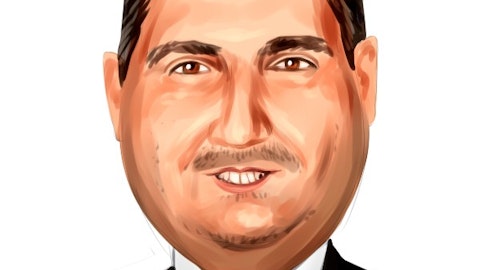Cigna Corporation (NYSE:CI) Q2 2023 Earnings Call Transcript August 3, 2023
Cigna Corporation beats earnings expectations. Reported EPS is $6.13, expectations were $5.98.
Operator: Ladies and gentlemen, thank you for standing by for The Cigna Group’s Second Quarter 2023 Results Review. At this time, all callers are in a listen-only mode. We will conduct a question-and-answer session later during the conference and we’ll review procedures on how to enter queue to ask questions at that time. [Operator Instructions] As a reminder ladies and gentlemen, this call, including the question-and-answer session, is being recorded. We’ll begin by turning the conference over to Ralph Giacobbe. Please go ahead.
Ralph Giacobbe: Thank you. Good morning, everyone. Thank you for joining today’s call. I’m Ralph Giacobbe, Senior Vice President of Investor Relations. With me on the line this morning are David Cordani, The Cigna Group’s Chairman and Chief Executive Officer; Brian Evanko, Chief Financial Officer; and Eric Palmer, President and Chief Executive Officer of Evernorth Health Services. In our remarks today, David and Brian will cover a number of topics, including our second quarter financial results and our updated financial outlook for 2023. Following their prepared remarks David, Brian, and Eric will be available for Q&A. As noted in our earnings release, when describing our financial results, we use certain financial measures, adjusted income from operations and adjusted revenues, which are not determined in accordance with accounting principles generally accepted in the United States, otherwise known as GAAP.
A reconciliation of these measures to the most directly comparable GAAP measures, shareholders net income and total revenues, respectively, is contained in today’s earnings release, which is posted in the Investor Relations section of thecignagroup.com. We use the term labeled adjusted income from operations and adjusted earnings per share on the same basis as our principal measures of financial performance. In our remarks today, we will be making some forward-looking statements, including statements regarding our outlook for 2023 and future performance. These statements are subject to risks and uncertainties that could cause actual results to differ materially from our current expectations. A description of these risks and uncertainties is contained in the cautionary note to today’s earnings release and in our most recent reports filed with the SEC.
Regarding our results, in the second quarter, we recorded after-tax special item charges of $5 million, or $0.01 per share, for the integration and transaction-related costs. Additionally, please note that when we make prospective comments regarding financial performance, including our full year 2023 outlook, we will do so on a basis that includes the potential impact of future share repurchases and anticipated 2023 dividends. With that, I will turn the call over to David.

David Cordani: Thanks, Ralph. Good morning, everyone, and thanks for joining our call today. For the second quarter, again, we delivered a strong performance, fueled by continued growth across our diverse portfolio of businesses. Today, I will review key strategic drivers contributing to our momentum and why we believe we are well-positioned to sustain our growth as we continue to support the health and vitality of those we serve with our differentiated solutions and capabilities. Brian will cover additional details about our financial performance in the quarter and our 2023 outlook. As part of our ongoing effort for you to hear more from members of our leadership team Eric Palmer, President and Chief Executive Officer of Evernorth Health Services, will be joining our call and is available to take your questions.
With that, let’s get started. In the second quarter, we delivered total revenues of $48.6 billion, adjusted earnings per share of $6.13 and cash flow from operations of $2.5 billion. We are pleased with our performance overall during the quarter and through the first half of the year. With focus on affordability and innovation, we are continuing to strengthen our competitive position and grow our businesses. In Evernorth Health Services, we saw another strong quarter of our market-leading pharmacy, care and benefits portfolio. Express Scripts, our pharmacy benefits business, harnesses our deep relationships, extensive clinical expertise and is delivering innovations and innovative solutions for those we serve. We’ve long been a leader in supporting access to prescription drugs and, to further enhance our efforts, we took a series of actions in the quarter, including launching Copay Assurance to support further affordability for patients, and ClearCareRX to provide our clients with broader choice.
We also introduced [Independent Rx] (ph), which is a first-of-its-kind support program for rural pharmacists that recognizes the critical role they play in improving access for millions of Americans. We will continue to lead the way through the current environment of elevated legislative and regulatory activity and we are encouraged by the positive recognition of our work to make safe, effective and affordable access of prescription drugs within reach for millions of people who need them. Our client retention is also strong, and we are continuing to build and expand new relationships. For example, we are making good progress for implementation with Centene, which begins on January of 2024. Our teams are working collaboratively and we are on track as we prepare to further improve affordability in serving 20 million Centene customers.
In the quarter, we had strong growth in Accredo, our specialty pharmacy business. In a moment, I’ll profile the deep clinical expertise and capabilities that make Accredo a differentiated leader in this space. Turning to Cigna Healthcare, we delivered another quarter of organic customer growth, reinforcing how well our consultative approach and capabilities continue to resonate in the market. Our U.S. commercial business continues to build momentum. We’ve had sustained success with commercial customer growth outpacing the overall market and 2023 is shaping up to be another very strong year for this business. With our affordability initiatives and deep consultative sales approach, we are delivering highly competitive total cost of care for employer clients, as well as providing programs supporting healthy engaged workforces that they need.
In U.S. government, our Medicare Advantage business is achieving above-market customer growth with high-quality affordable plans and targeted investments that we continue to make to further strengthen our network and offerings. In our individual exchange business, we will continue taking a focused approach by engaging customers to improve health outcomes and managing risks in the expanding population we serve. In the quarter, while our medical care ratio was generally in line with expectations, we did have an increase to our 2023 risk adjustment payable. Relative to the risk [adjuster] (ph) impact, we expect this to be a 2023 event, and we’ve already taken actions for 2024. And in our international health business, we drove continued innovation and growth in target markets with solutions for the [globally mobile] (ph) population and employees of multinational corporations as well as intergovernmental organizations.
Overall, our second quarter results showed that The Cigna Group is performing well with underlying strength in our complementary businesses. We believe we are well-positioned to continue growing our company and delivering on our commitments. With the strength of our results, we are increasing our outlook for full year revenue and customer growth, as well as cash flow from operations, and we are reaffirming that we are on track to deliver adjusted EPS of at least $24.70 for full year 2023. Now, I will talk about how we are working to sustain our momentum with our differentiated and diversified capabilities and our durable strategic growth framework. Our framework guides us in continuing to respond to customer, patient and client needs, as well as capturing growth opportunities within our foundational businesses and our accelerated growth businesses.
Additionally, we harness the power of our talent, client relationships and partnerships, as well as an expanding technology portfolio for cross-enterprise leverage. Technology increasingly provides us with opportunities to accelerate innovation and growth. Artificial intelligence and machine learning, for example, are capabilities further enhancing ways for us to support patients and their clinical care teams, as well as drive additional efficiency initiatives. Today, I’ll talk more about one of our accelerated growth businesses, Accredo, our flagship specialty pharmacy, where we have a competitive advantage in an area of growing needs and opportunity. Earlier this summer, we welcomed a group of investors to Warrendale, Pennsylvania at one of our Accredo clinical care sites.
The visit provided an opportunity to see the breadth of our specialty capabilities and the depth of our clinical expertise, a critical driver for the positive outcomes and impact we achieve for patients requiring complex and high-cost treatments for chronic conditions. Here are a few headlines from the day at Warrendale. First, Accredo has a proven track record of growth. Nearly five years ago when Express Scripts combined with Cigna, Accredo was approximately a $30 billion business. Today, Accredo has grown to approximately $60 billion. And in 2023, serves approximately 900,000 patients with some of the most complex conditions and needs. Accredo now represents about 40% of Evernorth’s total revenue, and because of its unique strengths, Accredo has grown faster than the overall marketplace.
Second, these secular tailwinds in the market create significant growth opportunities as we look to the future. Those who need specialty drugs make up about 5% of the population and they drive more than 40% of total healthcare costs across medical, behavioral and pharmacy services. This is fueling expected mid to high single-digit annual growth in what is already a specialty pharmaceutical market of approximately $380 billion. Biosimilars represent force of change and a substantial opportunity for further growth and impact, and we will leverage them for greater affordability for clients and patients. We’ve long been a leader in supporting greater adoption of biosimilars as we did with the wave of generic medications when they became available decades ago.
And like generics, we believe biosimilars will drive much-needed affordability improvements for those we serve and thereby create more financial capacity to pay for new pharmaceutical innovations today and as we look to the future. Third is the breadth of our clinical capabilities and use of data that further fuels precision and impact. We built and strengthened our clinical capabilities and far-reaching operating model over decades. Within Accredo, we have therapeutic resource centers with clinical teams of pharmacists, nurses, dietitians and social workers specializing in different disease states, such as blood and neurological disorders and multiple types of cancers. Unlike many of our competitors, we directly employ hundreds of field-based infusion nurses.
Today, they are located within 75 miles of approximately 90% of the U.S. population. And as they care for patients inside their homes, they provide better, more coordinated and personalized experiences, including addressing social determinants of health. With the clinical care model focused on each individual patient, we are able to provide a level of personalized clinical support that is vital in specialty pharmacy. Many new high-cost drugs for oncology, gene therapies and rare conditions are coming to market, further pressuring affordability for clients and requiring greater support for patients that take these complex medications safely and effectively. I would note, drug manufacturers also recognize our expertise and capabilities, as well as our superior outcomes that we produce with our unique, coordinated clinical model.
Putting all this together, we are excited about the accelerated growth opportunities we have with Accredo’s differentiated specialty pharmacy, and view it as a powerful growth engine for our company today and into the future. Now, stepping back to the enterprise level, I’ll briefly recap. We drove strong earnings that built on our momentum from the first quarter and last year. We delivered adjusted EPS of $6.13, strong customer, revenue and cash flow growth. Our progress gives us confidence to reaffirm our guidance of adjusted EPS of at least $24.70 for full year 2023, and we also remain on track for adjusted EPS of at least $28.00 in 2024. This reinforces how we are creating value for our customers and clients and leveraging differentiated capabilities to give us flexibility to continue performing well in a dynamic environment.
Now, Brian will share additional perspective about our performance in the quarter and our outlook for the rest of the year. Brian?
Brian Evanko: Thank you, David. Good morning, everyone. Today, I’ll review Cigna’s second quarter 2023 results and discuss our updated outlook for the full year. Second quarter results were strong, reflecting continued execution across the enterprise. Looking at the quarter specifically, some key consolidated financial highlights include: revenue growth of 7% to $48.6 billion; after-tax adjusted earnings of $1.8 billion; adjusted earnings per share of $6.13; and cash flow from operations of $2.5 billion. Revenue and cash flow both exceeded expectations, while adjusted earnings per share were slightly ahead of expectations. Our two platforms continue to perform well, with Evernorth posting solid top- and bottom-line growth, while Cigna Healthcare delivered results in line with expectations despite an unfavorable risk adjustment impact in our individual exchange business, which I will discuss shortly.
First, turning to Evernorth results. Evernorth continues to deliver strong performance. With second quarter 2023 revenues growing 10% to $38.2 billion and pre-tax adjusted earnings were $1.5 billion. Evernorth’s results in the quarter were driven by continued strong performance in our differentiated specialty pharmacy business, which had year-over-year revenue growth in the mid-teens, and our focus on providing a variety of solutions that drive affordability and lowest net cost for our customers and clients. Additionally, we continue to build out our cross-enterprise leverage capabilities, harnessing data and technology to accelerate innovation for customers and clients. And we also continue to make strategic investments to further enhance and expand our client relationships, diversify our portfolio of products and services, prepare for new clients in 2024, and advance our technology capabilities.
Overall, Evernorth has delivered strong first half results and we are well-positioned as we look to the back half of the year. Our diversified solutions allow us to sustain momentum by delivering differentiated value to our customers and clients, helping them overcome key healthcare challenges. Turning to Cigna Healthcare. Second quarter 2023 adjusted revenues grew 12% to $12.7 billion. Pre-tax adjusted earnings were $1.2 billion and the medical care ratio was 81.2%. The medical care ratio reflects some items specific to our individual exchange business that largely offset one another in the quarter. After receiving our first view of industry-wide risk adjustment data in early July, we increased our full year 2023 estimated individual exchange risk adjustment payable.
It’s important to note, this was primarily driven by two states. Within those two states, the unfavorable impact from the first half of 2023 was about $80 million, and was recognized in the second quarter. We expect a similar magnitude of impact in the back half of the year. Additionally, this impact is isolated to the 2023 calendar year, as we have taken corrective pricing actions and the impact to geographies in our 2024 rate filings. Specific to the second quarter, the unfavorable risk adjustment payable impact was largely offset by a favorable update to our 2022 risk adjustment receivable within the individual exchange business. Underlying fundamentals across the Cigna Healthcare segment continued to perform well as we further expanded our relationships and delivered affordability for our customers and clients.
As we have mentioned on prior calls, we planned and priced for more normalized levels of utilization this year. Our year-to-date claims experience has been broadly in line with this expectation across both Commercial and Medicare Advantage. Turning to Cigna Healthcare medical customers. We ended the quarter with 19.5 million total medical customers, growth of approximately 1.5 million customers year-to-date across all businesses. Within our government business, medical customers grew sequentially, and year-to-date, Medicare Advantage has grown 12%. Overall, Cigna Healthcare’s results in the quarter were solid as we demonstrated strong underlying fundamentals, despite the increased 2023 individual exchange risk adjustment payable previously mentioned, and we continue to grow our customer and client relationships, providing differentiated value and driving affordability.
Now, turning to our outlook for full year 2023. We have increased our expectations for full year 2023 consolidated adjusted revenues to at least $190 billion, driven by continued strength in our businesses as we continue to deliver innovative services and solutions for the benefit of our customers, patients and clients. We are reaffirming our adjusted earnings per share outlook of at least $24.70 per share, and we expect adjusted EPS to be split approximately evenly between the third and fourth quarters. In Evernorth, we continue to expect full year 2023 adjusted earnings of at least $6.4 billion. With respect to Evernorth earnings cadence, we expect mid-single digit year-over-year adjusted earnings growth in the third quarter, and mid to high single-digit adjusted earnings growth in the fourth quarter.
In Cigna Healthcare, we continue to expect full year 2023 adjusted earnings of at least $4.425 billion. We expect third quarter Cigna Healthcare adjusted earnings to be slightly below 55% of second half adjusted earnings to reflect seasonal patterns as well as the rate and pace of investments. This incorporates the impact from the estimated individual exchange risk adjustment payable in the second half of the year, which is offset by other items in Cigna Healthcare, including expense efficiencies. Additionally, we continue to expect our 2023 medical care ratio to be within the range of 81.5% to 82.3%. Switching gears, let’s move to our 2023 capital management position and outlook. Year-to-date through August 2, 2023, we have repurchased approximately $3.8 million shares of common stock for approximately $1.1 billion.
The continued strength of our cash generation gives us the confidence to increase our full year 2023 expected cash flow from operations by $500 million to at least $9.5 billion for the full year. Our balance sheet and cash flow outlook remain strong, benefiting from our highly efficient service-based model that drives strategic flexibility, strong margins and attractive returns on capital. Now, to recap, second quarter results were strong, reflecting high-quality underlying fundamentals in our foundational and accelerated businesses, giving us confidence to deliver on our 2023 adjusted EPS guidance of at least $24.70, and we continue to expect 2024 adjusted EPS of at least $28.00, consistent with our prior commentary. And with that, I will turn it over to the operator for the Q&A portion of the call.
See also 15 European Countries with Best Healthcare for Expats and 15 Most Consumed Meats in the World.
Q&A Session
Follow Cigna Holding Co (NYSE:CI)
Follow Cigna Holding Co (NYSE:CI)
Operator: [Operator Instructions] Our first question comes from Mr. Scott Fidel with Stephens. You may ask your question.
Scott Fidel: Hi, thanks. Good morning. Appreciate the color on the risk adjustment dynamics. I think that helps also explain some of the rate increases that we’ve seen you filing in some of those pertinent states like Georgia for 2024. My question is if we back out the risk adjustment impacts from both ’22 and ’23, can you give us an update on how you view sort of underlying utilization and cost trends in the marketplace and the individual business for 2023? And how you’d say sort of core, I guess, exchange margins are tracking towards your longer-term view in ’23? And as you put these price increases in for ’24, how that will sync up relative to the long-term sort of 4% to 6% pre-tax margins that you’ve historically sort of managed the individual business for? Thanks.
Brian Evanko: Good morning, Scott. It’s Brian. I’ll try to take each of those bites kind of one at a time. So, as I mentioned in my comments, in the quarter, we had an $80 million impact from the risk adjustment payable matter in 2023, which reflects essentially a true-up for the first two quarters of the year. But that was largely offset in the quarter by the favorable true-up we had on the 2022 risk adjustment settlement. The other residual piece within the individual exchange business is we had some favorable claim cost experience in the first half of the year. So, the $80 million was offset largely by the 2022 risk adjustment settlement, but also, to a lesser degree, by favorable cost trend within our individual exchange business, which reflects a younger, healthier population than what we had in 2022.
So claim costs there, certainly within check, but we had the larger payable, which creates the pressure point for the year. As it relates to the profit margins and how to think about where we are in ’23 and the rate increase impact on ’24, just for some context here, you can think of this business being approximately a $5 billion block for us in 2023 in terms of premium revenue. And we had shared on a prior call that we were anticipating the individual exchange book to run below our target margins within 2023. As you noted, our long-term target for this business is 4% to 6%. For the remainder of this year, we’re expecting another $80 million of risk adjustment payable impact across the second half, which, as I mentioned, will be offset by the strength across the broader Cigna Healthcare portfolio, including expense efficiencies.
But when you put all this together, the individual exchange margins in 2023 will be below our prior estimates. And for 2024, we have taken sizable price increases in our two largest states. So we would expect some degree of margin expansion in the individual exchange book overall in ’24 relative to ’23. The exact amount of that margin improvement will end up being a function of our geographic and customer mix in 2024 as we are likely to have fewer customers in the individual exchange business in 2024 relative to where we are in 2023. So, thanks for the question. Hopefully, you can follow all those moving pieces.
Operator: Thank you, Mr. Fidel. Our next question comes from Mr. A.J. Rice with Credit Suisse. You may ask your question.
A.J. Rice: Hi, everybody. I know at this point in the year, large employers are well on their way to thinking about their ’24 outlook as — both from health benefits and also on the pharmacy benefit side. I wondered if given you’ve got a great window on all of that, anything interesting to call out in terms of priorities for employers around benefit design, focus on particular categories of healthcare, whether — I know sometimes it’s diabetes, sometimes family planning. Anything on the cost management focus? I know there’s a lot of discussion about GLP-1s, and wonder whether they’re focused on trying to manage that more effectively. And then, just overall expectations in those customers around cost trends and — are they assuming it’s sort of a more normalized outlook going into ’24, or are they making any assumptions about pent-up demand or anything?





